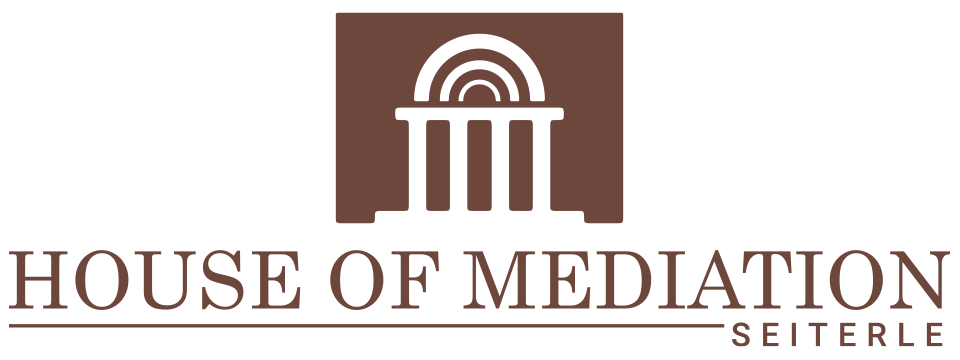Intra-company Mediation
crackling Conflicts? Clarify constructively!
– HOUSE OF MEDIATION

Is there a crisis atmosphere in the company that is disrupting the flow of business?
Scenarios
Do you also have an elephant in your conference room?
Group formation (‘Those over there’)
‘Department X never finishes on time, we’re always behind schedule because of them,’ is the comment in an emergency call between department heads because of various complaints about quality and completion date by customers. ‘Department Y always puts unnecessary time pressure on us and simply doesn’t want to understand that we work carefully and thoroughly here, unlike them,’ it immediately shoots back.
Unclear competences
In a major global corporation, sales figures have been falling in Europe for two years. For this and various other reasons, the European Head of Sales has been replaced five times in the last three years. The new European Head of Sales, who was appointed two months ago, has many new ideas to get sales back on track. In America, the incumbent Head of International Customer Relations is very upset about the sales figures in Europe and wants to take the helm. A conflict arises between the European Head of Sales and the Head of International Customer Relations over new measures.
Project management
The project would have an IRR of 15%? One deadline after the other bursts? Person X and person Y prefer to blame each other instead of looking for solutions.
Succession
I don’t want to disappoint my mother / father, but strictly speaking, I don’t want to take over her / his company. « My beloved daughter / son, you can’t do it that way – we’ve always done it that way… »
Employment relationship
Ambitious and highly motivated, person X proposes several corporate changes. Person Y sits at the table next to person X and thinks to himself: “Just two more years and I can retire.”
Unresolved conflicts do not remain without consequences and might continue to escalate
The nine escalation stages of a conflict according to Mr. Friedrich Glasl¹
1st Stage: HARDENING
There are different opinions that conflict with each other.
2nd Stage: DEBATES AND POLEMICS
There is a divergence of opinion, with both parties providing robust justifications for their respective positions. The opinion of the other party becomes increasingly less significant.
3rd Stage: ACTIONS, NOT WORDS
They stick to their own position and express their displeasure.
4th Stage: IMAGES AND COALITIONS
The difference of opinion has turned into a conflict. Allies are sought to support their own position.
5th Stage: LOSS OF FACE
The opposing party is publicly criticised and denounced in a negative light.
6th Stage: STRATEGIES OF THREATS
In der sechsten Stufe des Eskalationsmodells von Herrn Friedrich Glasl wird versucht über den Opponenten Kontrolle zu erlangen und ihn mittels Drohungen zur Aufgabe zu zwingen.
7th Stage: LIMITED DESTRUCTIVE BLOWS
Threats become the first actions that violate the moral code.
8th Stage: FRAGMENTATION OF THE ENEMY
The conflict has progressed to the point where the parties realise that they can only defeat their opponent individually, i.e. without the support of allies. Consequently, they attack their opponent’s network and endeavour to isolate them.
9th Stage: TOGETHER INTO THE ABYSS
The final stage of the conflict has been reached. The individual is so hurt that they are prepared to fall into the abyss themselves if they can drag the – in their view – guilty perpetrator into the abyss with them.
Unresolved conflicts cause financial losses²
Demotivation
People in conflict situations often bear this responsibility. Exhaustion can lead to a decline in motivation, which can in turn result in employees adopting a ‘work to rule’ approach.
Decline of Performance
Individuals in conflicted situations often demonstrate reduced productivity and substandard work quality. A lack of concentration can lead to signficant errors.
absenteeism
Escalated conflicts can result in resignations and/or sick leave (keyword: Bourne out).³
Termination(s)
Employees may decide to seek alternative employment due to one or more conflicts.
Reputational damage(s)
In the digital age, the dissemination of defamatory statements and ill will can have a detrimental effect on a company’s reputation.
Conflict Cycle
The cycle continues until the conflict is resolved.
Mediation
Resolved conflicts are beneficial for your company.
Focus - satisfied customers
The company’s customers are at the heart of its day-to-day business.
Fluid collaboration
Collaborations run efficiently and synergies are utilised.
Retention of employees
A positive working environment makes a workplace attractive.⁴
Resilience
In times of crisis, your company has reserves.
In short: Higher Profit⁵.

What is my objective in your mediation?
A pleasant working atmosphere without elephants.
My role is to facilitate the resolution of interpersonal dilemmas in professional environments, whether they are in the initial stages of becoming unresolved or have already reached a deadlock. My objective is to facilitate access to the needs of the parties involved in the conflict, as well as to identify the origin and cause of the conflict, so that all parties can reach a solution that is beneficial to them.
